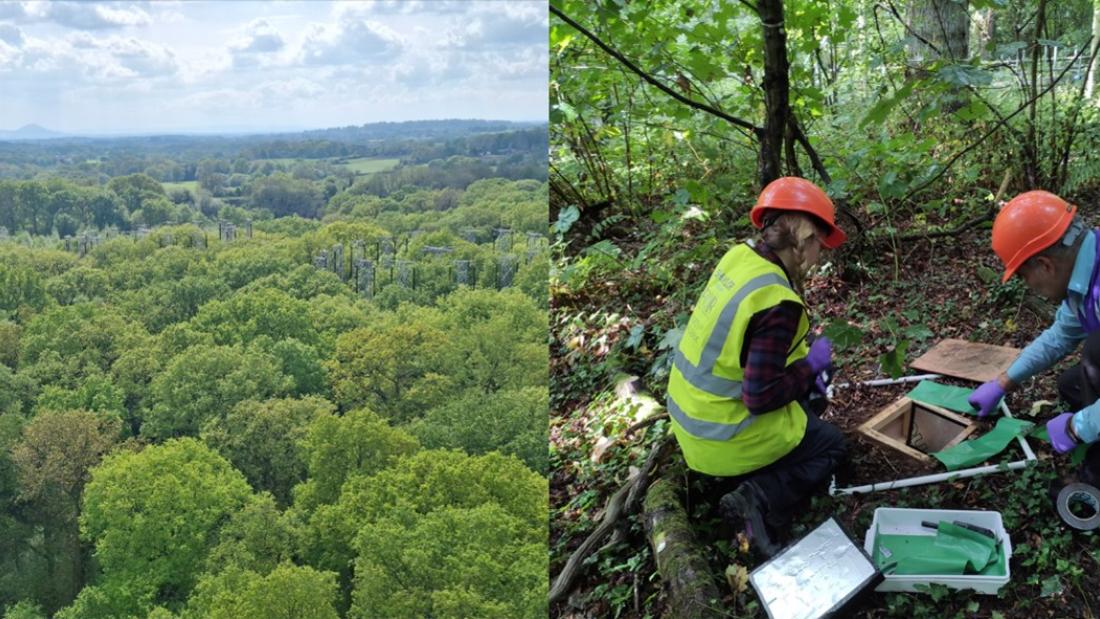Scientists reveal how mature trees could adapt to higher CO2 levels predicted for future climates
Scientists have revealed how mature trees could adapt to higher CO2 levels in the atmosphere of the future, enabling continued growth and the removal of carbon from the atmosphere.
Bangor University academics, working as part of an international consortium funded by the Natural Environment Research Council (NERC), contributed to research showing that mature trees can respond to the change of atmosphere by adjusting carbon allocation to promote “do-it-yourself” or “outsourcing” strategies for sourcing soil nutrients.
The study, published in the Proceeding of the National Academy of Sciences (PNAS) was conducted at the University of Birmingham Institute of Forest Research’s Free Air CO2 Enrichment (BIFoR-FACE), which is a large outdoor forest research facility.
Researchers discovered that trees growing in a CO2-rich atmosphere tactically use in-soil trading of carbon for nutrients.
Perspex-sided root boxes, buried in the forest, allowed scientists to access the soil and roots below giant approximately 180-year-old English oak trees growing in an atmosphere containing over a third more CO2. This is what the atmosphere is expected to be like by the mid-21st-century.
Measurements made after elevating CO2 in the forest for five years, showed that the oak trees increased their fine root branching systems by 73%. This “do-it-yourself” strategy helped the trees explore more of the soil at all times of the year to find and take up nutrients.
The “outsourcing” strategies they used, which involve trade partnerships with the soil microbial community, showed distinct seasonal patterns.
There was a 63% increase in the release or exudation of a cocktail of small organic molecules early in spring and autumn, which prime soil microbes to release nutrients locked up in soils, thereby meeting tree nutrient demands. There was also a 17% increase in the amount of symbiotic root-associated fungi in autumn.
In addition, under elevated CO2, trees not only invested more carbon in their in-soil trading, they also altered the cocktail of chemicals released as root exudate, providing yet one more ‘outsourcing’ strategy to gain nutrients and sustain growth.
Professor Andy Smith, from Bangor University’s School of Environmental & Natural Sciences said, “Forests have an important role as carbon sinks to help offset anthropogenic CO2 emissions. Our research reveals how forest growth can be sustained through novel below-ground strategies that maintain a sufficient supply of soil nutrients to continue assimilating atmospheric CO2 through photosynthesis and sequestering carbon.”
Dr Michaela Reay, the lead author from the University of Bristol, who carried out the research for this study while at the University of Birmingham, said, “Roots do not simply take up nutrients and water from soils but rather exhibit smart and dynamic choreography, which involves highly specialised trade-offs with soil microbes via varied nutrient exploration strategies throughout the year.
“These findings indicate that trees are more agile in optimising growth than previously thought and will continue to be agile under higher CO2 atmospheres as long as soil nutrient supplies are sustained.”
Senior author Professor Sami Ullah from the University of Birmingham said, “These mechanistic insights into how trees growing in future atmospheres acquire soil nutrients will have significant policy implications with direct relevance for climate mitigation initiatives such as the Paris Climate Agreement, the EU Green Deal, and the UK and EU net zero ambitions by 2050.”
Since the nutrients available in soil are not unlimited, the question now remains whether the extra carbon investment of trees in nutrient acquisition may eventually exhaust soil nutrient stocks.
Forest responses to enforced changes, such as higher atmospheric CO2, can take many years to reach a new balance point. The ongoing research at BIFoR-FACE will assess whether nutrient supplies can continue to meet tree nutrient demands.





